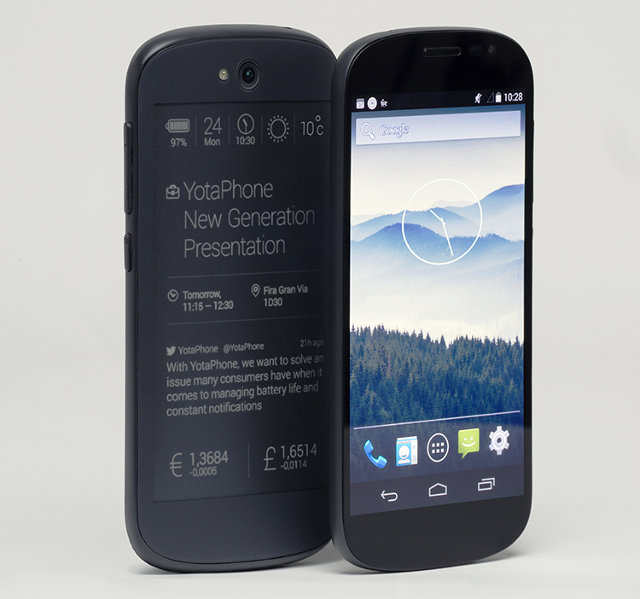E-ink is a wonderful technology. Easier on the eye than other display technologies and frugally power sipping, it's what allows your average Kindle to run for months on a single charge. In the bright, colorful world of multimedia smartphones, though, is there any room for an e-ink display?
Russian smartphone maker Yota Devices thinks that place is the back of your smartphone. Its next-gen Android smartphone, the YotaPhone, has a dual personality. On the front, it boasts a vibrant five-inch AMOLED color touch screen, and on the back? An always-on 4.7-inch e-ink display. The result is a smartphone that will give you up to 68 hours of battery life.

Forget the chips inside, the biggest drain on a smartphone's battery is the display. Blasting enough light to make its way through over 2 million indiscernibly tiny color pixels is enough to bring almost any smartphone battery to its knees in just a few hours, which is why we've all gone from charging our cellphones once a week just 10 years ago to having to charge them multiple times a day.
This electro-gluttony of LCD and OLED display technologies is what makes e-ink so attractive by comparison. E-ink displays are completely reflective, so they don't need a backlight to be read: "Pixels" display on an e-ink screen not because they have been lit from below, but because a small jolt of electricity has temporarily fused a titanium dioxide particle to the underside of the screen.
It's kind of like an Etch-A-Sketch. An e-ink display doesn't need to keep the battery going to show what's on the display, but the trade-off is that e-ink doesn't "come alive" like other display technologies. It's black and white, slow to refresh, and relatively low contrast: great for reading text, but crap at watching movies on YouTube, checking Facebook, etc.

That's what makes the YotaPhone's approach so novel. By having two screens, the makers of YotaPhone are acknowledging that much of the time we're checking our smartphones, we're doing so for relatively static, low-contrast forms of information: to see what time it is time, find out if we have any new texts or emails, and so on. Blasting light through a full-color AMOLED display for such tasks is just a waste of battery. The e-ink display can display anything that doesn't require a lot of color and pixels to push.
It's a clever implementation, and because the YotaPhone's e-ink display is fully touch-enabled, you can even use the black-and-white screen to play slower-paced games like chess and Sudoku, or read eBooks, without impacting your device's battery life. The result is that, depending on how you use this Android phone, you could get between 58 to 68 hours of battery life per charge.
The YotaPhone isn't available for sale yet, but it should come to the United States before the end of 2014, at a price comparable to a premium smartphone like the Samsung Galaxy series. We'll see if it's is a hit or not, but there's no doubt it's a clever design that solves one of the biggest problems facing smartphones today--battery life. And, unlike Apple's latest iPads, the YotaPhone does it without introducing revolutionary new tech.
Via TechCrunch